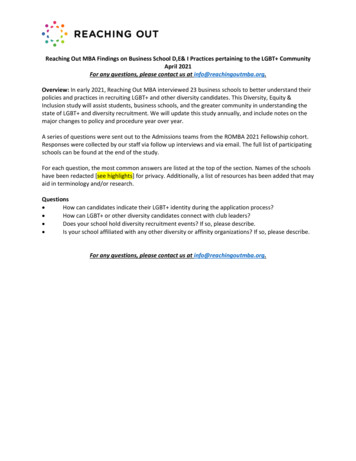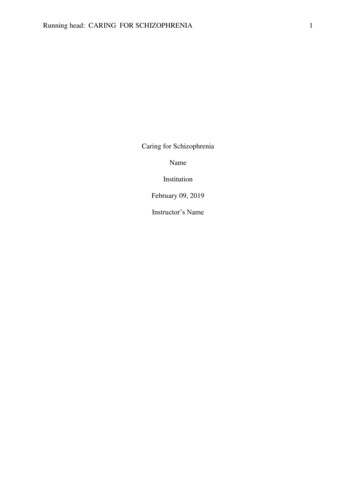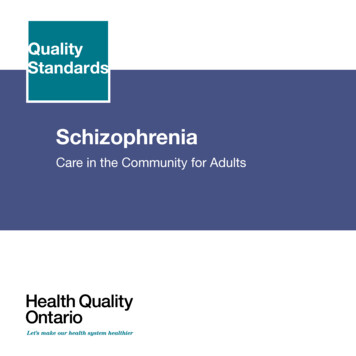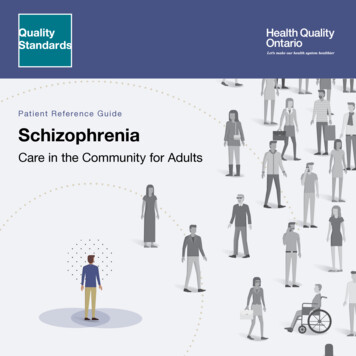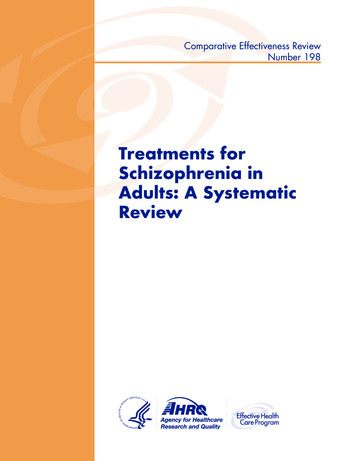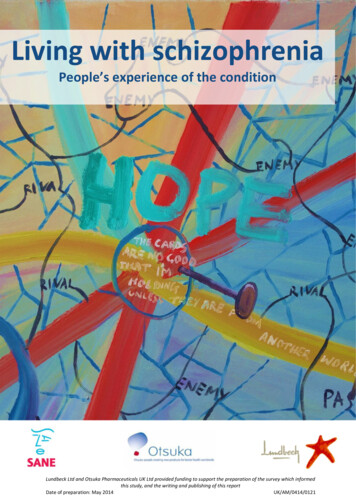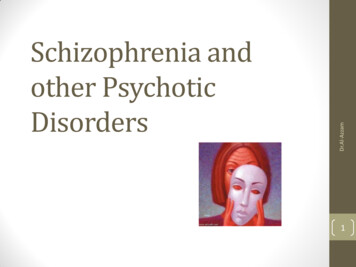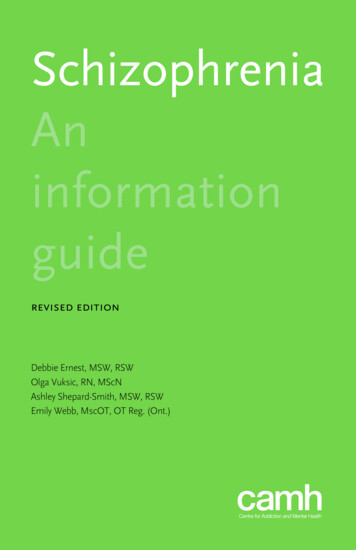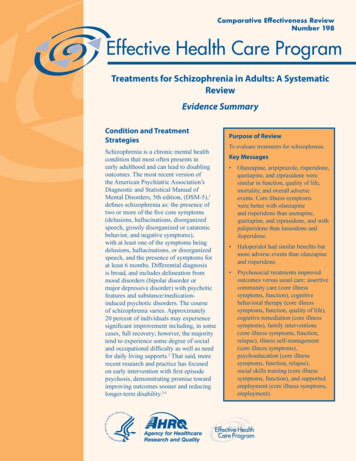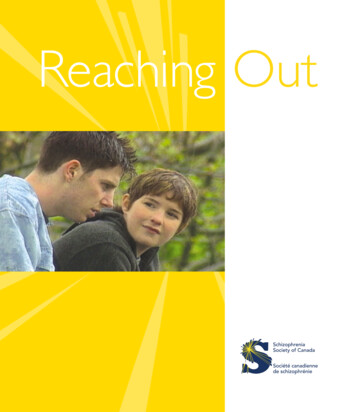
Transcription
Reaching Out
Reaching Out:The Importance of Early TreatmentReaching OutSchizophrenia Society of Canada 2003
Forew ordIntolerance and prejudice can only be changed by knowledge,understanding, and compassion.Schizophrenia affects one in every 100 Canadians. The usualtime of onset for this neurobiological illness is between 15 and25 years of age. Thus, high school students are in the age groupthat is at risk.Unusual behaviours often attributed to adolescence may beindicative of the onset of mental illness.It is important to be aware of the early symptoms of schizophreniaand know when to seek professional help. Early intervention andtreatment greatly improve outcomes for the illness.It is essential for school personnel to provide prompt response tostudents who may be developing mental illness. These students areat risk for further deterioration, and could be at risk for seriousharm. While confidentiality is important, the teacher must act as ajudicious parent to help the student get the required medicalattention in a timely fashion.Caution: Teachers should be prepared for potential disclosures.Teachers may be required to provide additional follow up if concernsare raised. Counsellors should be knowledgeable about local protocolsand pathways to appropriate medical care.Reaching Outi
THE REACHING OUT RESOURCE PACKAGE 20-minute video featuring a short drama and five people withschizophrenia talking about their experience with the illness Information for the teacher and students about schizophrenia Lesson plans for two periods Resources and suggestions to extend the learningIf you would like to have a knowledgeable resource personfrom the Schizophrenia Society in your classroom for the videopresentation, contact your local Schizophrenia Society branch orchapter, (check local phone book), or the Schizophrenia Societyof Canada 1-888-772-4673.The Schizophrenia Society of Canada is interested in hearing fromyou. If you find this resource useful, or if you have suggestions orquestions, please let us know. Email messages can be sent toinfo@schizophrenia.ca, or phone 1-888-772-4673.This resource may be photocopied for educational purposes.iiReaching Out
Ackno wledgementsProduction of this document has been made possible by a financialcontribution from the Population Health Fund, Health Canada.The views expressed herein do not necessarily represent the officialpolicies of Health Canada. Health Canada, for publication and distribution support Diane Pollard, Coordinator, Special Programs Branch,BC Ministry of Education Clem Meunier, Mental Health and Youth Policy Section,BC Ministry for Children and Families British Columbia School Counsellors Association British Columbia Teachers Federation Administrative staff, teachers and students who participatedin and provided feedback on this project:North Vancouver School DistrictBalmoral High – Janine DupreyCarson Graham High – Al Klatt, Mark LefroySutherland High – Elizabeth Bell, Doug Green,Rae Kaleem, Jenny MinaraRichmond School DistrictRichmond High – Barbara Doerksen, Pat Kehoe, Darlene MacklamVancouver School DistrictJohn Oliver High – John Chalk, Caroline HeshedahlJean Gelwicks, School Counsellor (retired) The initial Reaching Out pilot was developed, produced and editedby the BC Schizophrenia Society (BCSS) Education Committee:Joan Nazif, Chair, Education CommitteeJane Duval, Policy Development and Communications, BCSSJudith McPhie, Curriculum Development SpecialistLarry Richardson, Teacher, Vancouver S.D.Reaching Outiii
Tab le of ContentsFOREWORDACKNOWLEDGEMENTSiiiiPART I:INTRODUCTIONLearning OutcomesSynopsis of the Video12PART II:LESSON PLANSWhy teach Reaching Out?Notes to the TeacherLesson Plan OutlinesSuggested PreparationLesson Plan: Period OneTrue & False QuestionsTrue & False AnswersSchizophrenia SummaryEarly Warning SignsLesson Plan: Period TwoRole PlaysMajor UnderstandingsMajor Understandings Answers571012131718202123252945PART III:49OVERHEADSPART IV:RESOURCESExtending the LearningPlacement in School CurriculumGlossary of TermsRecommended ReadingsWeb SitesArticle “What is Psychosis?”Student Response FormBooklet: Basic Facts About SchizophreniaReaching Out63656669717381(Back sleeve of binder)iv
Par t I – Introduction LEARNING OUTCOMES SYNOPSIS OF THE VIDEOReaching Out
PART IIntroductionLear ning OutcomesaStudents will understand why it is important for themto know this information now:i) The early symptoms of schizophrenia commonly appearbetween the ages of 15 and 25 years.ii) Early intervention and treatment enhance the possibilityand opportunity for quality of life.bStudents will gain understanding about schizophrenia andwill be aware of the early warning signs:i) Schizophrenia is a brain disease.ii) Schizophrenia affects 1 in 100 people worldwide.iii) Early warning signs may mimic drug use.iv) Medication plays an important role in the treatmentof schizophrenia.v) Stigma and myths are barriers to treatment.vi) Good resources are available to help find information.cStudents will understand their role if they suspect a friendor family member may have schizophrenia:i) It is important to make contact with a responsible adult(counsellor, teacher, nurse, doctor, parent).ii) To support peers exhibiting symptoms requiresdeveloping the skills of:active listeningobservationempathy and compassiondStudents will understand that there is hope:i) Good treatment is available due to recent advancesin brain research and new medications.ii) People with schizophrenia can lead lives of purposeand quality.Reaching Out1
PART IIntroductionSynopsis of VideoLength: 20 minutesDRAMA STORYLINELisa is a high school student who is worried about her friend,Todd. When she shares her concerns with other friends, they saythat Todd is “just a loser”, and that “he’s probably doing drugs”.Lisa goes to talk to her counsellor, Mr. Cousins. She expressesher worries about Todd – his deteriorating appearance, his lackof interest in life, his puzzling hostility. She notes that “over thelast year, he’s really changed”.After asking about the possibility of drug use, Mr. Cousinswonders if Todd might be becoming ill. He discusses with Lisawhat they learned about schizophrenia and other serious brainillnesses. Mr. Cousins gives Lisa some references to look up onthe internet, and introduces her to Susan, a woman who hasschizophrenia. Susan tells Lisa about her own experience withthe illness. She also stresses the fact that if Todd really is ill, “it’svery important that he get help as soon as possible”.Lisa has known Todd’s family for years, so she decides to go andtalk to his mother. As Todd’s mother invites Lisa in, she tells Lisathat Todd’s counsellor has already called with similar concerns.2Reaching Out
PART IIntroductionSynopsis of VideoDOCUMENTARYAt relevant points in the video, the scene shifts and we meet fivepeople who actually have schizophrenia: Emily, Eric, Jamie, Paul,and Tim. They discuss their experiences with the illness. Theytalk about what it was like to be ill, how they finally got help, thesupport received from school, family and others, and the factthat good treatment is available, and it works.REVIEW OF IMPORTANT IDEASAt the end of the video, the five Major Understandings arereviewed using excerpts from the video to illustrate each idea.These could be used to reinforce the information at the end ofthe video in Period One and/or to re-introduce the informationin Period Two.Duration: 3 minutes.Reaching Out3
NOTES:4Reaching Out
Par t II – Lesson Plans WHY TEACH Reaching Out? NOTES TO THE TEACHER LESSON PLAN OUTLINES SUGGESTED PREPARATION LESSON PLAN: PERIOD ONE LESSON PLAN: PERIOD TWOReaching Out
PART IILesson PlansWh y Teach Reaching Out?People suffering from schizophrenia or other serious mentalillnesses (bipolar disorder, clinical depression, etc.) have typicallybeen viewed as having an illness that precludes living a productivelife. The causes of mental illness have often been incorrectlyattributed to a poor home environment, which is a heartbreakingmessage for families witnessing the struggle of one of their familymembers. People with schizophrenia and their families havesuffered from society’s fear and ignorance of mental illness. Theseattitudes are isolating and painful, and discourage public discussion.Recent brain research has brought increased knowledge andnew understanding. We now know: Schizophrenia is a medical illness. The symptoms of schizophrenia can be present at15 years of age or even earlier. Early intervention and treatment can stem the progressof the illness and improve life opportunities.Reaching Out presents an up-to-date view of schizophrenia,provides a message of hope, and encourages reflection,discussion and understanding. It discusses the important roleof friends and family in providing support, and encouragesresponsible help-seeking through school services. It alsopromotes discussion and reflection on the myths and fearssurrounding mental illness. The video shows people withschizophrenia who are living productive lives with the help ofmodern medications. The young people with schizophrenia whoare interviewed in the video offer a model of courage and hope.The information provided is supported by new researchand a greater understanding of the brain. It invites a morecompassionate and involved role for those whose lives aretouched by serious mental illness.Reaching Out5
NOTES:6Reaching Out
PART IILesson PlansNotes to the TeacherNotes to the Teacher1. This resource guide was designed to be used over twoperiods. Using two periods will maximize student learning,allowing group work, role plays and discussion time.However, if there are time constraints, Lesson One iscomplete in itself. If it is decided to further the study ofmental illness, there are additional ideas for extending thelearning on page 63.2. There are five Major Understandings that are emphasizedin this resource:1. Schizophrenia is a medical illness.2. Early intervention and treatment are important.3. People developing mental illness require support.4. People with schizophrenia can lead productive lives.5. The myths and stigma of mental illness are barriersto treatment.These five Major Understandings are reviewed at the endof the video, using excerpts from the video to illustrate eachpoint. (Duration: 3 minutes)3. The viewing of the video might cause anxiety in somestudents due to feelings or symptoms they have observedin themselves or others. Symptoms portrayed in the videocould be present for a number of reasons: use of drugs,depression, or another illness. They could also be partof the normal emotional upheavals of adolescence.(See “What is Psychosis?” page 73.)Reaching Out7
PART IILesson PlansNotes to the TeacherThe main point however, is that a combination of symptomsexhibited over an extended period of time and resulting inmarked behaviour or personality change can be linked to theearly stages of schizophrenia.4. Another concern is that students may attempt to diagnosethemselves or their classmates. This should be discouraged. Itshould be emphasized to students how important it is forthem to see a counsellor or other responsible adult if theyhave concerns about early warning signs in themselves orothers. The study of schizophrenia is a complex disease andits diagnosis requires the expertise of a highly trainedprofessional, namely, a physician and/or psychiatrist.Tim8Reaching Out
PART IILesson PlansNotes to the TeacherBEFORE SHOWING THE VIDEO:1. Inform the students ahead of time what is going to beshown. For instance: “Tomorrow we are going to see a video andhave a discussion about schizophrenia. This illness has not beenwell understood in the past. We will learn about the symptoms.We will learn how to help support a person who might be ill. It isunderstandable that viewing this material can cause some anxiety. Ifyou do not wish to be present for this session, please let me know.”2. Speak with a counsellor or with other support people inyour school. Let them know what you are doing and ask themto be present if possible or to be available if any student needsto come out of the session and speak with someone.3. If possible, have a second adult present with you in theroom so a concerned student who leaves the class receivessupport immediately. Be prepared for disclosure. Any studentwho makes a disclosure must be referred to a counsellorwithout delay.4. Read information for teachers on page 31 of the Basic FactsAbout Schizophrenia booklet found at the back of this binder.Reaching Out9
PART IILesson PlansLesson Plan OutlinesPERIOD ONEThis period has been designed to stand alone. It is stronglyrecommended however, that both Period One and Period Two beused, in order to reinforce the information with additional activitiesand to provide adequate time for discussion.1. Introduction and True & False Questions:What do you know about schizophrenia?*10-15 min2. Viewing the Video20 min3. Discussion: Response to the Video}*25-40 min4. Examining the Facts and Handouts for Students*Time allotted will depend on your school’s scheduling10Reaching Out
PART IILesson PlansLesson Plan OutlinesPERIOD TWO1. Major Understandings Group Work(with video segments)*25-35 min2. Role Plays*25-35 min3. Handouts*5 min*Time allotted will depend on your school’s schedulingIf you would like to have a knowledgeable resource person from the Schizophrenia Society in yourclassroom for the video presentation, contact your local branch or chapter (check your phone book),or the Schizophrenia Society of Canada at 1-888-SSC-HOPE (772-4673).Reaching Out11
PART IILesson PlansSuggested PreparationSuggested Prepar ationPERIOD ONE1.2.3.4.Read over Why Teach Reaching Out? (page 5)Read over Lesson One. (pages 13-16)Read over the Major Understandings. (pages 29-48)Read What is Psychosis? (page 73) and booklet, Basic FactsAbout Schizophrenia (in back binder sleeve) to augmentinformation
and pathways to appropriate medical care. ii Reaching Out If you would like to have a knowledgeable resource person from the Schizophrenia Society in your classroom for the video presentation, contact your local Schizophrenia Society branch or chapter, (check local phone book), or the Schizophrenia Society of Canada 1-888-772-4673. The Schizophrenia Society of Canada is interested in hearing .
